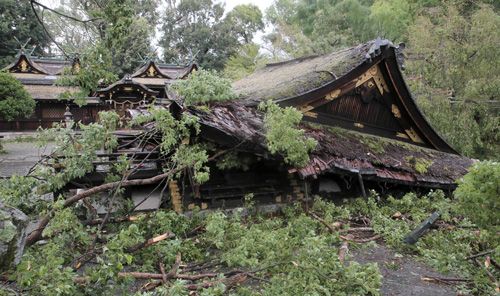Jebi, this season’s 21st typhoon has moved on, and I am fine – thank you to all my friends who have inquired the last two days. However, the damage in Kyoto (and the rest of Japan) is bigger than I had expected by just looking out of my own window.
I went to town today for a meeting, and along the river, many of the cherries there have lost at least small branches, and two were toppled altogether. Those are old trees, one of the uprooted ones had a girth of at least one metre! More trees were uprooted along the Imperial Palace, and this caused huge traffic disruptions in the city. Nijo castle has lost a number of its beautiful ornaments and will be closed for the time being. A big drama happened in Hirano shrine, which is famous for its cherry trees: Many of the trees were destroyed, together with one of the buildings that was a designated national treasure. All of its pillars broke in the storm, and the heavy roof now sits directly on the floor of the collapsed building.

Things were especially bad in Arashiyama, the western part of Kyoto city. There, many buildings are nearby the mountains, and the area is prone to floodings and landslides even without any typhoons. The famous Togetsukyo bridge lost its handrail for about half of its length, and there was a blackout on Tuesday evening because a number of electricity poles fell down. I hope nothing much has happened to Nonomiya Shrine – it will be the What’s up in Kyoto highlight for next month…
Outside of Kyoto, I think that Osaka and Kobe got hit worst. Kansai airport is still flooded, and I am sure you have seen the tanker that crashed into the bridge connecting the airport with the mainland. The repairs at the airport are estimated to take two to three weeks, but officials are confident that at least domestic flights will begin earlier. I don’t know how long it will take to repair the bridge though, and people are talking about rerouting international flights to Kobe or Itami (the old airport of Osaka/Kyoto).
However, repairs and cleanup have already begun. Even the bicycle path next to the river has been freed of branches, although they have just been moved aside. Homeowners also get ready to fix things, for example the building opposite of mine seems to have sustained some damage to its roof. So, things are being fixed (temporarily, I hope) in the typical Japanese manner: by duct-taping a large plastic tarp over the hole…

